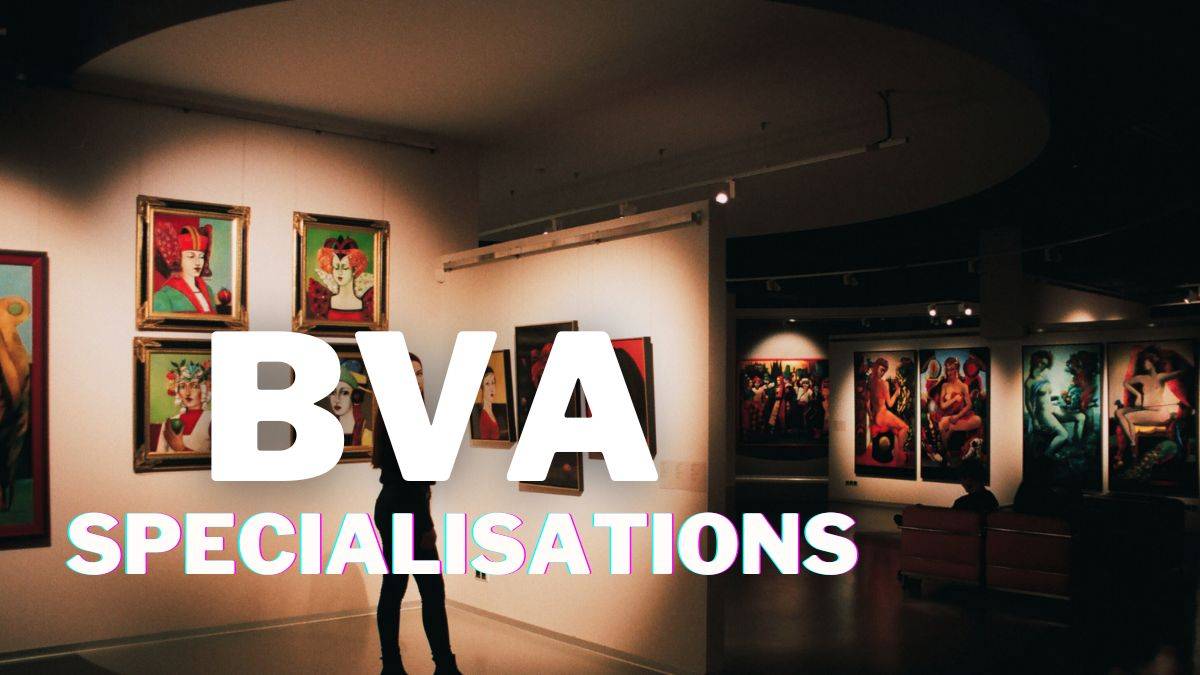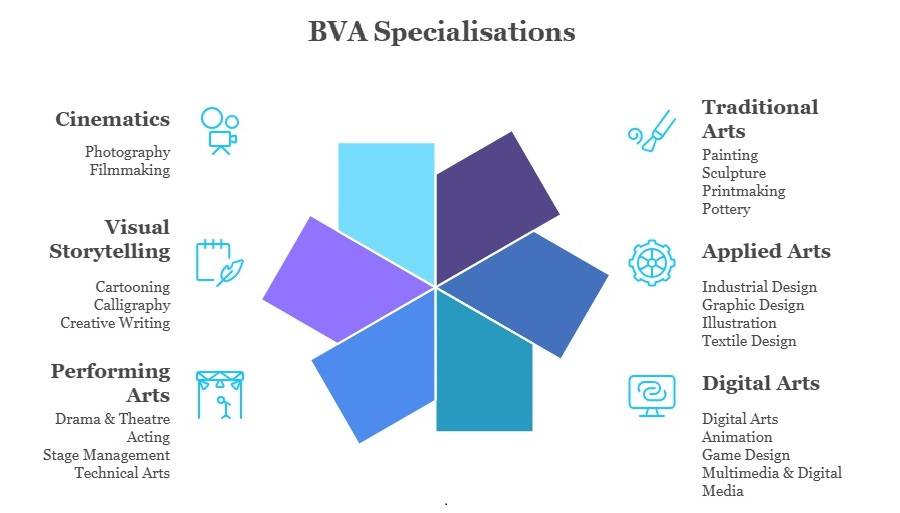A Complete Guide to BVA Specialisations, Skillsets, and Top BVA Colleges in India
A Bachelor of Visual Arts (BVA) is an undergraduate degree designed for students considering a career in the visual arts and sharpening their creativity. If you are interested in painting, sculpture, photography, animation, or design, then pursuing a BVA course can be helpful. We have listed BVA specialisations and top colleges in India offering those specialisations.
Traditional arts are age-old, hands-on techniques that use materials like paint, clay, and wood, which distinguish them from digital or non-traditional arts.
Painting
Painting specialisation involves different types of painting techniques including oil, acrylic, water colour, and digital painting. The course will develop the students' creative expression, understanding of colour theory, and visual communication of ideas. Students are going to explore both traditional and contemporary painting methods.
Sculpture
Sculpture focuses on producing 3D objects from materials such as clay, wood, stone, or metal. In the Sculpture specialisation, students master historical and modern sculpting techniques as they explore abstract and representational forms.
Printmaking
The student becomes acquainted with each stage of the artistically made world that draws on multiple printmaking processes. It ranges from etching, lithography, and woodcut to screen printing. Printmaking is a technique that encourages students to play with the quality of the surface, the number of layers, and the mass production of their artworks. It is where technical skills get combined with creative thinking.
Pottery & Ceramics
The Pottery & Ceramics specialisation covers aesthetic and utilitarian aspects of working with clay. It includes skills of hand-building, wheel-throwing, glazing, and firing to create ceramic sculptures and functional pieces such as bowls and vases.
- 2. Applied Arts
- 3. Digital and Multimedia Arts
- 4. Performing Arts and Theatre
- 5. Visual Storytelling and Communication
- 6. Cinematics and Visual Media
- Top BVA Colleges in India
2. Applied Arts
Applied arts use art forms in functional design and practical visual communication.
Industrial Design
Industrial design covers artistic skills with business applications in advertising, product packaging, and print design. Students learn to solve real-world problems by being visually creative through design thinking. The discipline combines aesthetics and functionality.
Graphic Design
Graphic Design includes typography, layout design, logo creation, and branding, both manually and with the help of computers. Students learn to design for the web, print media, and digital interfaces by focusing on clarity and impact.
Illustration
Illustration focuses on drawing images that tell or depict an idea. Students will learn editorial illustration, children's book illustrations, comic art, and digital art techniques. The course develops a personal aesthetic and visual storytelling.
Textile Design
Textile Design focuses on the creation of prints, patterns, and textures in fabrics for fashion and interior design. Students are given a chance to practice methods of weaving, block printing, and digital textile design.
3. Digital and Multimedia Arts
Merges art with digital technology and multimedia resources to create contemporary expressions.
Digital Arts
This specialisation covers topics like digital art, motion graphics, image manipulation, and interactive design. Students learn to channel creativity through software, tablets, and new technologies such as AR/VR Integration.
Animation
In the Animation specialisation, students learn to develop motion-based narrative through 2D and 3D animation. Subjects include rigging, character modelling, scene layout, and post-production.
Game Design
Game Design courses include character development, environment creation, gameplay, and user experiences. It teaches students to develop interactive games using both artistic and technical skills.
Multimedia & Digital Media
Emphasises interactive and audiovisual materials, such as web design, video, and digital installations. Promotes narrative through various formats and media.
4. Performing Arts and Theatre
Live or recorded performance arts that integrate imagination with expression and technical precision.
Drama & Theatre
Students study stagecraft, performance studies, and dramatic literature. These focus on building presence, emotion, and narrative through physical and vocal training.
Acting
The specialisation in acting develops skills in movement, voice, improvisation, and acting for stage and screen. Students engage in performances and build confidence performing in front of both audiences and cameras.
Stage Management
Teaches the backstage production that brings a show to life—planning, logistics, and technical application. Time management, team coordination, and equipment handling are skills that students learn.
Technical Arts
Technical arts involves designing and building sets, lighting, and props for stage productions. Brings engineering fundamentals with artistic flair to create engaging environments.
5. Visual Storytelling and Communication
Visual storytelling and communication specialisation emphasises use of text and illustration in order to convey meaning, emotion, and information.
Cartooning
In the cartooning specialisation, you will learn to create comic strips, political cartoons, and caricatures. This specialisation is aimed at humour, satire, and rapid visual communication.
Calligraphy
Calligraphy specialisation talks about lettering and writing systems that are aesthetically pleasing. Students use materials such as nib pens and brushes to generate expressive text.
Creative Writing
Creative Writing teaches narrative form, storytelling, dialogue, and print and screen editing. Students write fiction, poetry, and scripts across genres.
6. Cinematics and Visual Media
Cinematics and visual media are forms of art whose ultimate goal is static and moving images recording for narrative or commercial purposes.
Photography
In the photography specialisation, students will learn about composition, illumination, camera skills, and image post-processing. The course will combine artistic imagination with technical accuracy for use either personally or in business.
Filmmaking
Filmmaking and Video and Film Production cover all phases of production, including writing, directing, shooting, and editing. Students produce short films, documentaries, and experimental video making.
Top BVA Colleges in India
Listed below are the top BVA colleges in India offering a specialised degree, along with their respective fees.
| MFA College Name |
Specialisations |
Tuition Fee |
| INR 51,720 |
||
| INR 6,00,000 |
||
| INR 7,16,000 - 9,36,000 |
||
| INR 1,50,000 |
||
| INR 75,000 |
||
| INR 50,000 |
||
|
|
INR 5,20,000 - 6,00,000 |
|
| INR 3,24,000 |
||
| NA |
||
| INR 4,80,000 |
Read More:



Name: Rashmi Karan
Education: M.Sc. Biotechnology
Expertise: IT & Software Entrance Exams
Rashmi Karan is a Postgraduate in Biotechnology with over 15 years of experience in content writing and editing. She speciali
Read Full Bio